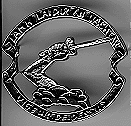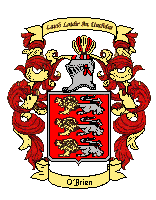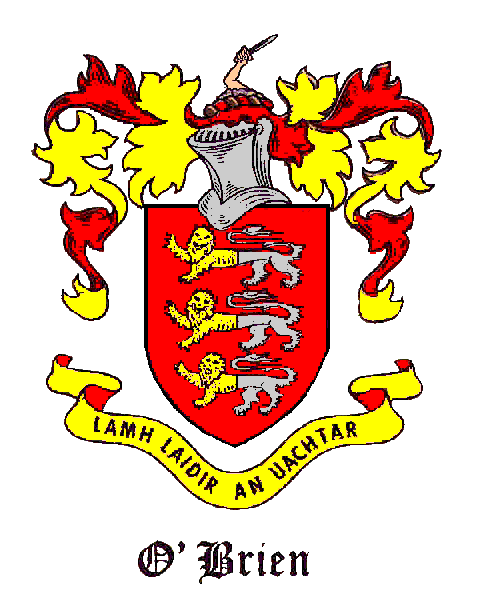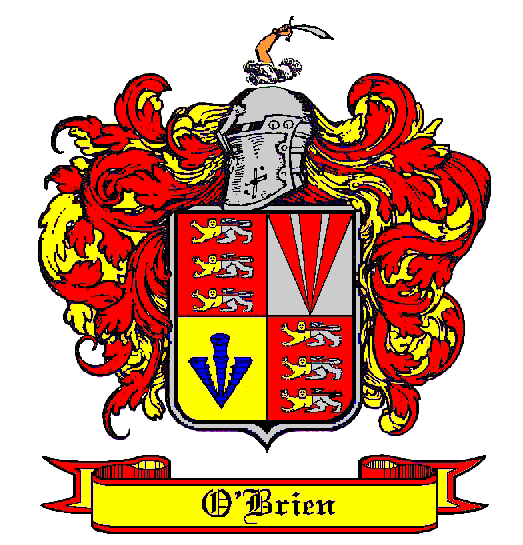 |
MPRM Group Limited President: Micheal J. O'Brien O'Brien |
 |
MPRM Group Limited President: Micheal J. O'Brien O'Brien |
 |
 |
 |
"Lamb Laidir an Uchtar (the strong hand uppermost)
|
More information about the O'Brien family? |
Visit the Official O'Brien Clan website
|
The O'Brien Family Coat of
Arms Thanks to: Heraldry was brought to Ireland with the Anglo-Normans in 1169 A.D. The Irish nobility began adopting this type of heraldry during the next couple of centuries. But Ireland was not void of heraldic symbols of its own. Various annals tell of Irish kings and their banners with symbol and color descriptions that existed before the Anglo-Normans came. But these symbolic banners were not hereditary. First, one must understand the principle of heraldry. It's main purpose was to identify an individual on the battlefield. In time, those symbols became hereditary and also associated with property, i.e., nobility. Means of differencing the basic heraldic symbol came into use to show the structure of a family and so that the symbols, although slightly modified, would show relationship to the original arms and give individual identity. The common beflief that a coat-of-arms belongs to all of a surname is incorrect. Heraldic arms are granted (in the early days they were assumed) to an individual and his heirs male forever. A change in this philosphy is in Scotland, where each individual must matriculate their arms in the court of the Lord Lyon, King of Arms. The first Chief Herald of Ireland was Edward MacLysaght, who wrote several books on Irish family history and heraldry. The Chief Herald wrote that the basic arms of the clan did't just belong to the chief but to all clan members, and labeled these heraldic arms as "sept (clan) arms." Under the Gaelic order the clan lands belonged to the people and not to the chief. Thus, the basic clan arms belonged to the people of the clan. One could display them on their wall to show clan membership, but if one wanted to use those arms on stationary, silver, etc., then MacLysaght advised that that individual petition for a grant of arms from the Chief Herald's office. Individual arms are considered a personal matter by the herald's office. One's personal arms can reflect the clan arms or be totally different, which is unlike Scotland, where if one has a surname of one of the Scottish clans or families, their arms are based upon those of the chief, keeping the clan or family in order. Irish heraldic arms can be found designed in three categories, lending a distinct style to Irish heraldry: 1) Norman = Use of three identical symbols. Use of ordinaries, simplicity. 2) Anglo-Irish = Use of ordinaries with Gaelic symbols. A main charge surrounded with three identical but different charges. 3) Irish or Gaelic = Use of Gaelic symbols. Supporters used to hold the main charge on the shield. Simple or complex designs. Tournaments that were held in Scotland, England and Continental Europe , contributed heavily to the advancement of heraldry and its prageantry to promote the individual knight and his heraldic arms. But no tournaments were ever held in Ireland. Heraldry was used on banners and property identification and sealing of documents. One of the unique aspects to Irish heraldry is that the Gaelic symbols are also literary, symbols which recall to the viewer Irish mythology and the Emerald Isle's ancient history. An example is the arm of the Nuadu, King of the de Danann Gods, who is remembered in the symbol of a hand or arm holding a sword. Nuadu lost his arm in battle. Since a king could not be disfigured and rule, Nuadu had to abdicate his throne. The divine silversmith, Dian Cech, fashioned a silver arm for Nuadu and with magic attached it to his body making it possible for him to reclaim his kingship, which he did. The arm (or hand) holding a sword is recalling this event in Irish literature. Nuadu in Gaelic means "cloud maker." Other heraldic literary symbols are the boar (fierceness), stag (sovereignty), sword (Nuadu or the sword of light and truth), serpents and lizards (rebirth), hand (derbfine or true family of four generations), and the red hand (story of a king who cut off his hand and flung it to shore to be the first to touch land making his claim first). As for the O'Briens, the first known symbol recorded is the battle flag of the Dalcassians, recorded in the Book of Leinster as being the color of red, purple, gold (yellow) and dung (brown), but the design is unknown. The Dalcassians held the right to lead the King of Munster's army into battle. King Brian Boru's banner is described differently in two sources. One design states that his banner was blue with an arm holding a sword along with a sun. The second design is the famous three lions. The first is probably correct as shall be outlined later. Nuadu's arm was used by the early kings of Munster, who belonged to the Eoghanachta (MacCarthy) Dynasty. These Eoghanachta king's throne name was "Magha Nuadhad," which means "the slave of Nuadu." The Schottenlkoster (Irish monastery) of st. James Abbey at Reggensburg, Bavaria (Germany), used this Irish symbol of Nuadu as part of their monastery symbol. Many of the monks and abbots were from Munster and its benefactors were Munster kings and noblemen. The abbey arms are like that of the Province of Connacht and the abbey's arms are a dimidation of the double eagle of the Holy Roman Empire impaling an embowed arm holding a sword. When the Ui Briains became kings of Munster and High-Kings of Ireland in the Eleventh century, this ancient Eoghanachta symbol was transferred over to the Ui Briains and the abbey arms were used by King Conchobhar Slapar Salach Ua Briain (d. 1049). The Chief Herald of Ireland's office has stated that the first heraldic arms used by the Ui Briains is "gules a dexter forearm holding a sword in pale all proper." This lends some continuity to King Brian's banner design. However, various branchs of the Ui Briains used different symbols such as a griffin, a wolf and the Waterford Ui Briains used a lymphad (ship). On 1 July 1543, the heraldic arms of the Kings of Thomond were changed forever when Murrough "The Tanist" Ua Briain, last and 57th King of Thomond, surrendered his kingdom to king Henry VIII of England, which kingdom was regranted to him with the English title of 1st Earl of Thomond (for life) and later Baron Inchiquin (heirs male), holding all in fee simple. This resignation of Thomond to King Henry VIII took place at Greenwich by the Thames River in England, with Murrough's nephew, Donough Ua Briain in tow being a minor. Donough later became 2nd Earl Thomond and created Baron Ibrackan (his live ended in 1774, with the Viscounts of Clare. To show this resignation of the Gaelic Order and showing loyalty to the new king and government, the old heraldic arms were discarded and Henry VIII granted to Murrough his own personal arms, "gules three lions passant guardant in pale or," but the arms for Ua Briain were differenced to, "gules three lions passant guardant in pale per pale or and argent." From an English point of view this was a great honor, but to the Irish, clan and Gaelic Order, it was surrender and defeat. At this same time the Gaelic spelling of Ua Briain was changed to that of O'Brien by England. What is interesting to note, is that the ancient arms were not lost but tranferred to become the crest. The only difference was the addition of clouds, which alluded to the Gaelic motto, "Lamb Laidir an Uchtar (the strong hand uppermost)." Soon after Greenwich, the O'Brien arms become quartered with three piles. Author Ivar O'Brien, believes that this may be an earlier symbol (it first appears in 1543 as the 2nd and 3rd quarters with the lions to Murrough O'Brien, Baron Inchiquin). The author conjects that the piles may belong to O'Brien-of-Arra, but there are strong circumstantial evidence that the three piles were adopted with a difference from the Anglo-Norman Baron and Knight, Sir Guy de Bryan of Devonshire and Pembroke, who was stationed at Dublin. Sir de Bryan died in 1390 with no male heirs, and possibly King Brian Catha Ua Briain, upon his arrival at Dublin to swear fealty to King Richard II, it is speculated by Ivar O'Brien that the King of Thomond assumed the de Bryan symbol because of name similarity. The de Bryan arms are, "or three piles meeting in base azure." The O'Brien quarter is differenced as, "argent three piles meeting in base gules." When Sir Henry Sidney was sent to Ireland to be Lord Deputy of Ireland, O'Brien again speculate's that this is when the 3rd quarter of "or a pheon (arrow head) azure," was added by the Earl Thomond to show loyalty to Sidney, who used in his personal heraldic arms the pheon. The Gaelic war-cry was "Lamh Laidir an Uchtar." But in 1613 a second French motto was added, "Viguer Du Dessus,", meaning "strength from above," a poor translation of the Gaelic war-cry. Only a few Irish families have a badge using a Celtic knot as a symbol. Found on a corbel next to the fireplace at Lemenah Castle, is the "O'Brien Knot." This unique knot is the badge of the O'Brien branch of Lemenah and Dromoland. Today, The O'Brien, Sir Conor O'Brien, Chief of the O'Brien Clan, has extended the use of the basic O'Brien arms and crest for use by the O'Brien Clan of North America and he included the O'Brien Knot. These arms may be displayed as outlined at the beginning of this article by MacLysaght. The O'Brien also mentioned that the crest and Gaelic motto may be used by all clansmen/women. Together, The O'Brien and Garaidh O Briain, worked on a basic clan badge design using the crest, motto and knot. There is no set design for Irish clan badges as there is in Scotland. Use of the quartered arms, supporters, baronet's badge, dual motto and baron's coronet, are strictly for the use by the Chief, The O'Brien, who's personal arms these various elements are. The last symbol used by an O'Brien, was the regimental banner of daniel O'Brien, 4th Viscount Clare, who commanded the Irish regiment in the service of France known as "O'Brien's Regiment, later called Clare's Regiment (a.k.a., Clare's Dragoons). This regiment was originally organized by Charles O'Brien, 3rd Viscount, for King James II army during the Williamite Wars of 1688-1690. When King James' army was defeated in Ireland, rather then serve the new king, William of Orange, the Irish soldiers volunteered to follow their king into exile. Many served in the armies of France, Spain and Austria. These regiments were known as "The Wild Geese." Uniforms for the Irish regiments in the service of France in 1762 were basically; white pants, shirt and knee socks, with a red coat that was trimmed in the regiment color with a matching colored vest (black for Dillon, green for Bulkeley, yellow for Clare, white for Rothe, and red for Berwick), a black tri-corned hat with a white cockade (indicating their Jacobite support). The regimental flag was quartered with a cross of St. George overall, fimberated white. Quarters 1 and 4 were the regimental color, and quarter 2 and 3 were red. In the center of the red cross was a gold harp, and over the harp was a gold Stuart crown, which was also in each quarter bendwise. On each end of the cross was written in gold "In Hoc Signo Vinces," "in this sign thou shalt conquer." |
MPRM Group Limited
|
|